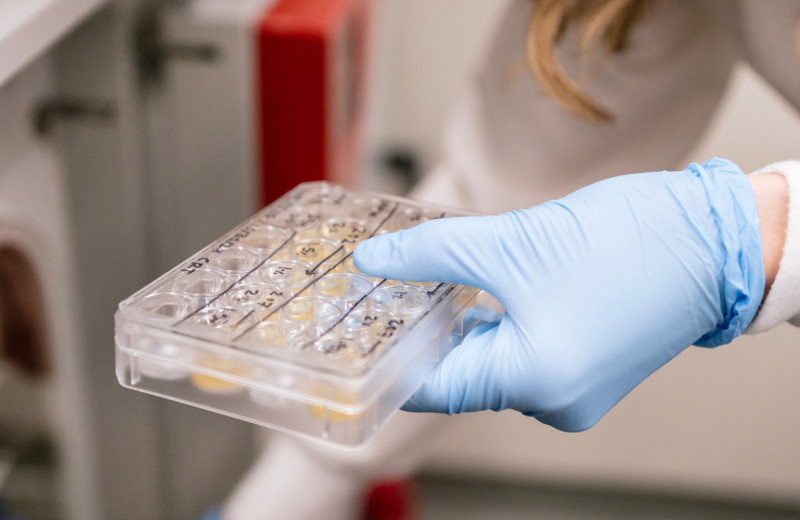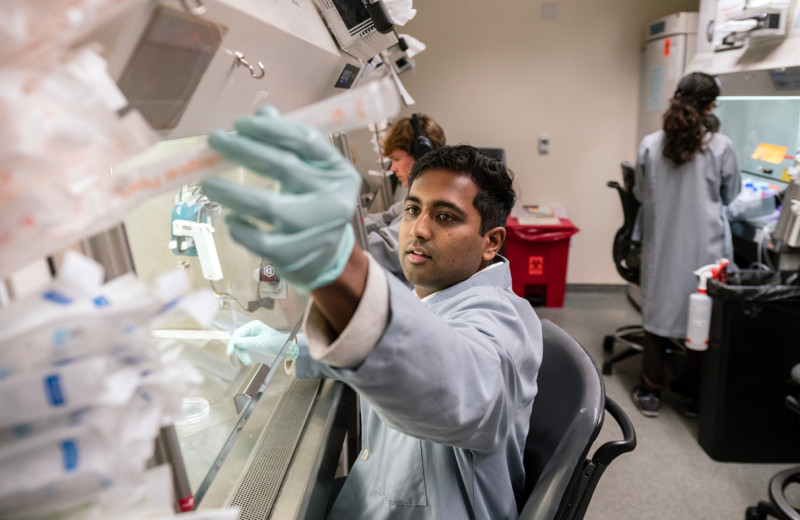Gladstone NOW: The Campaign Join Us on the Journey✕

A joint Gladstone-UCSF study led by Drs. Lennart Mucke and Dena Dubal revealed a gene linked to longevity also improves learning, memory. This discovery opens a new path for treating Alzheimer's and other aging-related diseases. [Photo: Chris Goodfellow]
A scientific team led by the Gladstone Institutes and UC San Francisco has discovered that a common form of a gene already associated with long life also improves learning and memory, a finding that could have implications for treating age-related diseases like Alzheimer’s.
The researchers found that people who carry a single copy of the KL-VS variant of the KLOTHO gene perform better on a wide variety of cognitive tests. When the researchers modeled the effects in mice, they found it strengthened the connections between neurons that make learning possible – what is known as synaptic plasticity – by increasing the action of a cell receptor critical to forming memories.
The discovery is a major step toward understanding how genes improve cognitive ability and could open a new route to treating diseases like Alzheimer’s. Researchers have long suspected that some people may be protected from the disease because of their greater cognitive capacity, or reserve. Since elevated levels of the klotho protein appear to improve cognition throughout the lifespan, raising klotho levels could build cognitive reserve as a bulwark against the disease.
“As the world’s population ages, cognitive frailty is our biggest biomedical challenge,” said Dena Dubal, MD, PhD, assistant professor of neurology, the David A. Coulter Endowed Chair in Aging and Neurodegeneration at UCSF and lead author of the study, published May 8 in Cell Reports. “If we can understand how to enhance brain function, it would have a huge impact on people’s lives.”
Klotho was discovered in 1997 and named after the Fate from Greek mythology who spins the thread of life. The investigators found that people who carry a single copy of the KL-VS variant of the KLOTHO gene, roughly 20 percent of the population, have more klotho protein in their blood than non-carriers. Besides increasing the secretion of klotho, the KL-VS variant may also change the action of the protein and is known to lessen age-related cardiovascular disease and promote longevity.
The team’s report is the first to link the KL-VS variant, or allele, to better cognition in humans, and buttresses these findings with genetic, electrophysiological, biochemical and behavioral experiments in mice. The researchers tested the associations between the allele and age-related human cognition in three separate studies involving more than 700 people without dementia between the ages of 52 and 85. Altogether, it took about three years to conduct the work.
“These surprising results pave a promising new avenue of research,” said Roderick Corriveau, Ph.D., program director at NIH’s National Institute of Neurological Disorders and Stroke (NINDS). “Although preliminary, they suggest klotho could be used to bump up cognition for people suffering from dementia.”
Having the KL-VS allele did not seem to protect people from age-related cognitive decline. But overall the effect was to boost cognition, so that the middle-aged study participants began their decline from a higher point.
“Based on what was known about klotho, we expected it to affect the brain by changing the aging process,” said senior author Lennart Mucke, MD, who directs neurological research at the Gladstone Institutes and is a professor of neurology and the Joseph B. Martin Distinguished Professor of Neuroscience at UCSF. “But this is not what we found, which suggested to us that we were on to something new and different.”
To get a closer look at how the gene variant operates, the researchers used mice that were engineered to produce more of the mouse version of klotho and found that these mice learned better at all stages of life. Put through mazes, these transgenic mice were more likely to try different routes, an indication that they had superior working memory. In a test of spatial learning and memory, the mice with extra klotho performed twice as well.
Researchers then analyzed the mouse brain tissue and found that the mice with elevated klotho had twice as many GluN2B subunits within synaptic connections. GluN2B is part of the N-methyl-D-aspartate receptor, or NMDAR, a key receptor involved in synaptic plasticity.
The researchers found more GluN2B-containing receptors in the hippocampus and frontal cortex, brain regions that support cognitive functions. When the researchers gave the mice a drug that blocks the action of these receptors, the klotho-enhanced mice lost their cognitive advantage.
Gene Editing Strategy Could Treat Hundreds of Inherited Diseases More Effectively
Gene Editing Strategy Could Treat Hundreds of Inherited Diseases More Effectively
Scientists at Gladstone show the new method could treat the majority of patients with Charcot-Marie-Tooth disease.
News Release Research (Publication) Neurological Disease Conklin Lab CRISPR/Gene EditingGenomic Maps Untangle the Complex Roots of Disease
Genomic Maps Untangle the Complex Roots of Disease
Findings of the new study in Nature could streamline scientific discovery and accelerate drug development.
News Release Research (Publication) Marson Lab Genomics Genomic ImmunologyThe Genome Editing Playbook Is Different in Neurons
The Genome Editing Playbook Is Different in Neurons
The striking findings of a new study could influence how gene therapies are designed for many genetic diseases.
News Release Research (Publication) Neurological Disease Conklin Lab Doudna Lab CRISPR/Gene Editing



